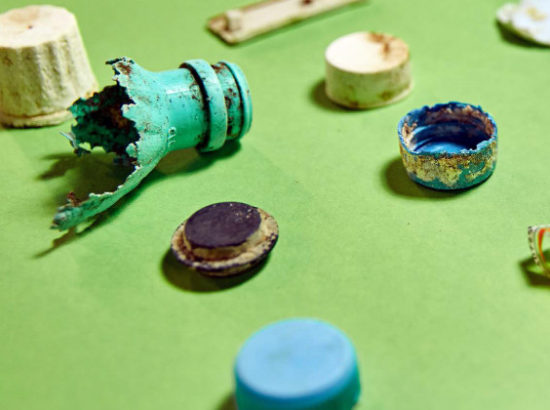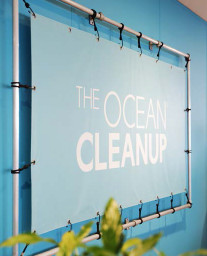Published: Tuesday May 16 2017Youthful entrepreneur Boyan Slat is pioneering a technology to remove the millions of tons of unsightly plastic trash floating on the surface of the world’s oceans, which endangers marine species and pollutes the human food chain.The five plastic garbage patches circulating in the world’s largest oceans have long been seen as a threat to marine life which is poisoned by this persistent material or becomes entangled in it. It also introduces organic pollutants such as PCBs and DDT into the food chain of three billion people. Yet removing the plastic with ships and nets is a lengthy and prohibitively expensive business.However, new technologies have been developed by a Dutch foundation to rid the oceans of millions of tons of plastic by harnessing their currents so that they effectively do most of the job themselves. The Ocean Cleanup, founded in 2013 by an 18-year-old student, plans to launch its pilot in Pacific waters by the end of 2017, which will be tested and refined until a fully operational system is completed. ‘Big problems require big solutions, and it will take hundreds of millions of dollars to clean the oceans,’ says Boyan Slat, founder and Chief Executive of The Ocean Cleanup. ‘Computer simulations predict a 100 km installation can remove half the Great Pacific Garbage Patch in 10 years.
Topics:
Jessica Martin considers the following as important: In Conversation With, Ocean Cleanup, Ocean technology, Pictet Report, plastic pollution
This could be interesting, too:
Perspectives Pictet writes House View, October 2020
Perspectives Pictet writes Weekly View – Reality check
Perspectives Pictet writes Exceptional Swiss hospitality and haute cuisine
Jessica Martin writes On the ground in over 80 countries – neutral, impartial and independent
Youthful entrepreneur Boyan Slat is pioneering a technology to remove the millions of tons of unsightly plastic trash floating on the surface of the world’s oceans, which endangers marine species and pollutes the human food chain.
The five plastic garbage patches circulating in the world’s largest oceans have long been seen as a threat to marine life which is poisoned by this persistent material or becomes entangled in it. It also introduces organic pollutants such as PCBs and DDT into the food chain of three billion people. Yet removing the plastic with ships and nets is a lengthy and prohibitively expensive business.
However, new technologies have been developed by a Dutch foundation to rid the oceans of millions of tons of plastic by harnessing their currents so that they effectively do most of the job themselves. The Ocean Cleanup, founded in 2013 by an 18-year-old student, plans to launch its pilot in Pacific waters by the end of 2017, which will be tested and refined until a fully operational system is completed. ‘Big problems require big solutions, and it will take hundreds of millions of dollars to clean the oceans,’ says Boyan Slat, founder and Chief Executive of The Ocean Cleanup. ‘Computer simulations predict a 100 km installation can remove half the Great Pacific Garbage Patch in 10 years.’
His interest in cleaning up the ocean’s garbage patches began in the summer of 2011, when he was just 16. While diving in the seas off Greece, he was amazed to find more plastic bags than fish. For a high school science project, he investigated what was behind the plastic pollution problem, and why it was said to be impossible to clean up. ‘I became obsessed with the issue, and couldn’t think of anything else for a year – even after I started studying aerospace engineering at university. Eventually, the scale of the problem prompted me to see if I could apply what I was learning in my lectures to cleaning up the oceans. If it didn’t work out, I could always come back and continue my aerospace studies.’
By mid-2013, he had formulated his initial thoughts on using the natural ocean currents to let the oceans clean themselves. ‘A professor had said that the reason why it was so hard to remove the plastic garbage was that it is constantly circulating around the oceans. I wondered whether we could take advantage of that movement to make the plastic come to us.’

For the development of a cleanup technology, it is essential to understand the problem, specifically the dimensions of the individual objects and the plastic accumulation as a whole. The nature and amount of the debris determine the design of cleanup systems, the logistics of hauling plastic back to shore, the methods for recycling plastic, and the costs of the cleanup.
With his scientific background, he started by looking at the data behind the problem. Estimates of the amount of plastic in the ocean ranged from tens of thousands of tons to tens of millions, so he launched a series of missions to get more accurate figures. One was what he called the Mega Expedition, when he chartered 30 boats in August 2015 to scan the area from Hawaii to San Francisco over three weeks.
Some of the larger pieces were less than 20 years old – recognisable objects like a hard hat and a games console case. Smaller pieces probably dated back a lot further, having been broken down by ultra-violet light to sizes that are found in the stomachs of marine life such as sea turtles, while the chemicals can end up in the food chain when eaten by fish. ‘It was not only unique in scale, but we also used very big nets so that the number of large plastic pieces could be established for the first time. They aren’t normally caught by the small nets used for such surveys which collect mainly tiny pieces of plastic. We also found ten ghost nets, discarded fishing gear which can weigh more than a ton and often entangles marine species.
‘To quantify the numbers of large objects, we hired an airplane in September 2016, calling it Ocean Force One. We surveyed the ocean with 20 trained observers using cameras and infra-red sensors to detect plastic garbage. We also used the lidar systems employed by Google self-driving cars to see 3D images. ‘On the first flight over the edge of the garbage patch, we spotted more than a thousand large objects in two hours, ten times more than expected.’ To extract the plastic garbage spread out over a wide area of ocean requires it to be concentrated.
The Ocean Cleanup’s plan is built around a large V-shaped barrier of floating booms moored to the sea-bed, collecting the debris as the ocean flows through them. ‘We built a 100 metre-long prototype and tested it in the North Sea off the Netherlands. We found that it concentrated the plastic as hoped for, reducing the concentrations of garbage and the size of the patches. We anticipate using this approach on a much larger scale in the oceans’ garbage patches, with vessels coming monthly to take away the collected plastic. ‘The plan is to launch a pilot operation during 2017, and if that is successful start a full deployment within three years. We calculate that by the end of their lifespan, the boom systems will have reduced plastic debris in the oceans by at least 50 per cent.’

The Ocean Cleanup was initially financed by crowdfunding, but has now begun to attract commercial investors. A third of the funding for the North Sea prototype was provided by a Dutch dredging and marine contractor, and another third by the Dutch Government. Boyan Slat believes that investing in clean-up operations will be attractive to companies, which can put their logos on the booms, use the operations to motivate staff and demonstrate their social responsibility to customers. And he hopes that the plastic can be recycled – perhaps even making the project self-sustaining.
The northern Pacific will be the first priority because it accounts for a third of the plastic debris in the world’s oceans. And since 86 per cent of all the plastic in the sea originates from Asia, the ocean clean-up could be complemented by campaigns on land to reduce the amount that ends up in the oceans. The foundation is carefully considering potential spin-offs of its technology that would be meant for deployment in rivers and coastal areas. The idea behind these spin-offs is to intercept plastic before it reaches the oceans.
There are still issues to resolve, such as how to ensure that the operating array is robust enough to survive Pacific storms. But 2017 will be an important landmark for The Ocean Cleanup, according to Boyan Slat. ‘We hope to have the pilot operation in the water before the end of the year, and be ready to start cleaning up the great garbage patch in the northern Pacific from 2020.’
